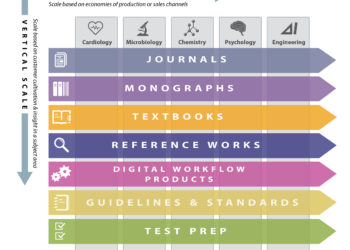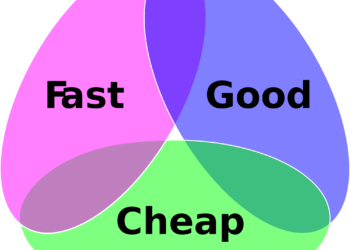We live in an age of corporate consolidation — big companies continue to acquire or merge with smaller firms at a rapid pace. Where there once were dozens cor hundreds of companies in some industries, there are now a handful — airlines, brewers, and rental car companies are some examples, as noted in the clip below from the most recent episode of Last Week Tonight with John Oliver:
The scholarly publishing business is quite consolidated as well, and becoming more so day by day. Ten companies control more than 75% of the market, and notifications about journal transfers from societies to the larger publishers sprinkle our emails. Yet, talk to most editors and publishers, and they think we’d be better off with a diverse market made up of many players — university presses, society publishers, successful non-profits. Many economists agree, seeing a diverse business space as more supportive of jobs, innovation, and long-term growth. Consolidation comes at a cost.
There seem to be counter-forces at work, where major slices of activity are made freely available to help foster innovation, level the playing field, and resist consolidation. Open source software is one such possible counter-force. Open source solutions are popping up around scholarly communication and publishing infrastructure. Recently, eLife and the Coko Foundation announced a new open source publishing platform. This new platform seems to spring from eLife’s prior open source platform effort, Continuum, which hasn’t been updated recently except for some recent incident tickets, and has had zero releases. eLife isn’t the only open access publisher dabbling in open source — PLOS has been developing Ambra as an open source platform, as well. The Chan Zuckerberg Initiative’s investments in Meta and bioRxiv are also said to carry with them a strong preference for open source solutions.
Might open source save the day by leveling the playing field in some way? Or will it simply feed the same tendencies of the rich to get richer, the big to get bigger, and the small to pay the price?
In general, companies are relying on open source solutions more often. There are many good offerings at the infrastructure level for them to choose from, and saving money on boring old infrastructure is alway alluring. But there are carrying costs for any infrastructure, both seen and unseen. There are indications these companies may be playing with fire, as a recent survey found that only 15% of more than 800 companies had policies in place to manage their open source software pipeline, and that the majority worried about security exposures, license violations, and intellectual property liabilities. Even in the hands of large firms with deep resources, open source isn’t a slam dunk. It has to be managed, and that has a cost.
Open source has become such a norm in major swaths of the technology community that investment in infrastructure companies by VCs has effectively stopped, according to a recent interview with investor Maha Ibrahim:
On the enterprise side, we have been open sourced to death. Almost every part of the stack up to the app layer is getting open sourced. Which is phenomenal for the developer, it’s phenomenal for cost structure of enterprises — it’s a very difficult environment, though, in which to be an enterprise investor.
In our industry, open source is sometimes conflated with open access (OA), but the two are not related in any functional way. You can have an open source subscription platform, for example. Scholastica, an OA platform provider, specifically and nicely calls out the reasons OA works for them but open source does not, writing:
Most of the great open source software are meant for widespread use: Linux, PHP, jQuery. By being applicable to millions (or billions) of potential users, their ecosystem of potential contributors is suitably large so that if only 0.001% of users contribute code, the project still grows and can improve over time. Also, if the tool is meant for programmers, the user base has the skills to contribute.
We don’t think that scholarly publishing meets these criteria. There are a few million people involved in contributing research, but vastly fewer who actually serve as editors of journals and hence are the real users of such software. Similarly, while there are many scholar-programmers, most scholars are not Ruby or Python programmers, so the number of contributors becomes very very small and would not realize the potential of open source with tens of thousands of active contributors really growing the product.
When it comes to open source, scale poses a problem. Our market is relatively small — Google makes an Elsevier in revenue every few weeks and Facebook has more than 2 billion users. Compared to technology companies in technology industries, we have a relative paucity of engineers and computer scientists willing and able to devote volunteer hours to open source scholarly projects.
While unrelated in other ways, OA and open source may have similar dynamics when it comes to scale. Unexpectedly to many proponents, OA has accrued to the benefit of larger organizations via market consolidation — OA’s pricing and pace economics reward efficiency, production leverage, and market penetration. It’s easier for a multinational to hoover up authors in remote and emerging markets, impose bargaining power and economies of scale via production systems, and realize the efficiencies of dealing with the multitude of mandates for a broader portfolio, spreading the costs. Smaller players address smaller market segments, have less expansive production capabilities, and often have to reinvent the compliance wheel.

The way OA rewards and reinforces scale is captured in a particularly useful and reflective interview recently about this and other related topics. In the interview, Leslie Chan, one of the original signatories of the Budapest Open Access Initiative, expresses deep reservations about how OA has been coopted by large publishers. But the centralization effect doesn’t end there:
. . . [Gold OA] is simply re-solidifying the status quo, even more restrictively… because only the rich institutions are able to pay to publish!
Chan also asserts that funders are using the OA model to impose their points of view disproportionately:
At the same time, we see that multilateral agencies such as the World Bank, and a growing number of private funders – such as the Wellcome Trust , Gates Foundation, are also enacting open access policies. All of these donors have their own agendas and philosophies. By making their funded research open (while other, peer-reviewed academic material remains behind closed paywalls), these donors are actually becoming over -represented in terms of their contribution towards knowledge, particularly in the areas of health and development. Because they are the voices that everyone can easily access, their views and findings are more likely to be taken up and perpetuated by local institutions that cannot afford to pay for alternative knowledge sources.
The imposition of scale on individual, organizational, and philosophical levels as an unanticipated consequence of OA permeates the interview with Chan — from OA as anti-feminist to OA over-representing the philosophies and priorities of established funders and philanthropists, who represent a type of oligarchy coming into scholarly publishing.
The converse of this set of concerns about the changes caused by OA policies is that many of the business factors that allowed publishing to be diverse — business models that are value-based instead of cost-based, recurring revenues via subscription renewals, and strong advertising revenues based on audience reach — have been deprecated, leaving smaller and society publishers wondering about the future of their publishing programs. Some will survive, but many more will contract with larger publishers to remain viable, feeding market consolidation.
OA works for larger commercial firms because it scales up well for them. With OA publishers now pushing open source initiatives, might things change?
There have to be enough people with enough skill and enough time and enough passion deriving enough benefit from the open source solution for it to remain viable.
In the technology space, open source solutions have worked well. Projects like Linux, Ubuntu, Apache, MySQL, Node.js, and GNU are all well-known and heavily used. They are made by and for the technology community, so they are also associated with the “cool kids,” which seems to have a non-trivial effect on decision-making about adoption of the open source framework — some feel that technology should have a hip, altruistic flair to it, and embracing open source is like getting your hand stamped at the White Hat Club.
Yet, a key element in a successful open source environment is scale — there have to be enough people with enough skill and enough time and enough passion deriving enough benefit from the open source solution for it to remain viable. Programmers are in high demand, so they are the weakest link in any open source development effort. For the big, showy efforts in the tech space, it’s a badge of honor to be associated with major open source projects, and there are networking and professional benefits as well as the interest in solving tough problems with smart collaborators.
In our space, there are very few successful open source offerings. Some open source library management systems have attempted to defy the many sources of gravity in software development using an open source approach, only to be brought down by the fact that developers’ time is scarce, their interests vary, and there aren’t enough to go around. There are also very few indirect benefits to be derived from participating in niche and relatively uninteresting development projects around production systems or projects that will never scale past a certain size.
Open source tools succeed when used by larger technology firms that can attract the talent and make the investments to mine every ounce of value from these free services. This supports the notion of market consolidation. Within the technology community, such dissatisfaction with the consequences of open source software is not hard to find. As one programmer writes:
. . . we’ve built a system where the only major beneficiaries of Open Source Software are corporations and startups. Instead of empowering the people and regular computer users, we’ve empowered VCs and tech billionaires.
Does Google get more out of open source solutions like Node.js? Has Apache made it easier for Facebook to promulgate servers? Has open source accelerated the rise of the dominant commercial players in the digital space? If so, the trend echoes some of the concerns about OA now being voiced.
With open source, such animus stems from the unpaid nature of the work, which is essentially a barter relationship — I’ll give my time and talent to something I hope to indirectly benefit from later. The barter aspect of open source is worth considering. As Joanna Bryson implored us at the recent ALPSP meeting to stop bartering for data, the same might be said about software. Bartering for technology doesn’t deliver good-paying jobs, broaden the economic base via taxes or salaries, or create sustainable commercial models.
It’s also clear that open source isn’t required for success — commercial and proprietary technology tools on the market, including Java, Atlassian, Salesforce, and GitHub, are popular. Because they are commercial, their success delivers tax revenues, creates vibrant companies of their own, employs people, and speeds innovation in a more reliable manner.
There is also a fair and possibly growing amount of business risk in basing technology decisions on open source solutions. Most recently, the Equifax breach may have been made possible because of a vulnerability in some open source software the company used. While not absolving Equifax of responsibility, the incident reminds us that even open source solutions need to be vetted and managed and upgraded.
These indirect risks around the sustainability of open source efforts are worth considering. A critical factor includes programming person-power, which is dependent on goodwill. Not getting paid while seeing major corporations make hay from your volunteer labor both erode goodwill. Continuity is another issue, as noted in a Wired magazine article on the topic:
. . . despite this mainstream success, many crucial open source projects—projects that major companies rely on—are woefully underfunded. And many haven’t quite found the egalitarian ideal that can really sustain them in the long term. Some open source developers struggle with burnout, while others have trouble working their way into the open source community.
Can open source succeed in scholarly publishing? Maybe, but it faces a talent crunch to start. If it overcomes that, then we may see it supporting even more market consolidation as the larger players scale up the benefits while the smaller players watch from the sidelines. It’s happening with OA, and some fundamental dynamics suggest it could also happen with open source.
Budgets are moral documents, and business models are governance structures. These things matter. To preserve a multi-layered and vibrant scholarly publishing economy, we should think carefully about ensuring that the economics don’t all accrue to the benefit of the few and the largest, and that we are not building on sand.
Discussion
14 Thoughts on "Naiveté Scene — Open Source vs. Scale in Scholarly Publishing"
Very insightful and informative, Kent, if only as a source for knowing of the many players in platforms. Two small points and a tangent. 1. Is OJS too small to warrant a mention? 2. What are the incentives that cause so many open source platforms to emerge if the underlying purpose is to enhance scholarly communication and diminish the role of the large, overcharging, publishers. The tangent: In addressing the proliferation of platforms, is there a role in the platform environment for formal not-for-profit structures that ensure that an organization cannot sell itself to a commercial entity? In Canada, this is the case for registered charities.
Hi Rowland. OJS definitely fits into the picture. I was focused more on things that were happening recently, but thanks for adding that. As for the incentives, I think there is a desired altruism around technology, but one that is hard to realize. As I mention, when that altruism yields something different and robust, it’s then easy for the big players to appropriate and integrate, deriving much of the benefit.
I think registered charities in Canada can do an asset sale. That’s how non-profits in the US deal with selling things to commercial entities. They can’t “sell themselves,” per se, but they can sell their assets.
Seems strange and suggestive that you would leave MIT’s PubPub out of this discussion.
I made no representations about being exhaustive. Now consider it included via your comment.
Ok. Except that if we consider the fact that in general the Web was invented as a scholarly communication tool, and that Berners Lee is now a prof at MIT, what’s going on there in terms of scholcomm (PubPub) might be a priority consideration for a piece like this and not something to be left to the comments– if this was intended as a good faith effort, that is. Finding a balance in informing scholars is worthy of a good level of depth, while not needing to be exhaustive.
For readers interested in how openness can be considered holistically, TBL’s latest is here .
Per the TBL essay you’re referencing, it’s not on topic — this post is about whether open source software development practices level the playing field or benefit large, entrenched forces. The essay you reference is about the open web, so more about net neutrality, as far as I read it.
The web began in academia, but is now something far beyond what many imagined — and of less clearcut benefit, with active cyberwarfare occurring presently, affecting elections, international relations, and more. The lesson for me is about unintended consequences. The intention may have been academic and scholarly communication. The result borders on a surveillance state with major corporate powers dominating our lives (Equifax, Amazon, Facebook, Google). Maybe looking before we leap is not such a bad thing?
How you wish to interpret your own topic is up to you.
However, you also make this claim: “There are also very few indirect benefits to be derived from participating in niche and relatively uninteresting development projects around production systems or projects that will never scale past a certain size.” My point is that the project at MIT (PubPub) suggests otherwise. It is a pertinent project because it reflects an approach to the issues you’re considering from a scholarly community which has attracted TBL as a faculty member. That disposition towards scholarly communication on the web is worth noting for your readers as is the fact that broader concerns about openness (net neutrality) might be a better use of your readers’ time if one is truly concerned about level playing fields or undue benefits to “large, entrenched forces,” as you put it.
“Can open source succeed in scholarly publishing?” It already has, in the form of the Public Knowledge Project’s Open Journal Systems https://pkp.sfu.ca/ojs/ , originally released in 2001 and still the only affordable approach for manuscript submission, tracking, and publishing for journals without substantial resources and profits that are not willing to sell their rights and futures to a multinational publisher.
PKP’s OJS and PKP’s related projects are worth noting. Affiliated with Simon Fraser University and with about C$900,000 in salaries and a hefty share of government grants keeping it afloat, PKP seems to be a hybrid of government-supported software development and pure, community-driven open source.
The question remains — will or has the open source software developed helped the larger players in the industry? That is, have they plucked the software PKP developed, expanded it, and used the free labor to save themselves work and money, and to further cement their place at the upper-end of the industry?
Ubiquity Press did exactly that with OJS. While not huge they leveraged OJS to provide low cost professional publishing services to small societies and other groups of scholars.
Your comment that PKP relies upon a “hefty share of government grants” to keep it afloat is misleading. PKP’s 2016 Annual Report summarizes our financial sources as follows: $510K from journal hosting services; $348K from grant funding; $217K from community support; and $104K from in-kind support provided by the SFU Library. It is worth noting that PKP’s largest financial source is from journal hosting services which reflects a classic sustainability model for open source — charge for services based on the free software. Our grant funding varies from year to year and comes from both the public and private sector. And it is used to support a variety of PKP research and development initiatives, not all of which are directly associated with the OJS software.
As PKP’s Managing Director, I would maintain there is a role for community-based, open source publishing platforms in the scholarly publishing environment. They provide a cost-effective solution for many journals, especially those in the developing world. PKP has identified over 10,000 currently active OJS journals that have published at least 10 articles in the past year. In response to your closing question “Can open source succeed in scholarly publishing?” I think these numbers provide a more positive answer than “maybe.”
Every University around here seems to run a GPL Eprints 3 server now.
Clearly, open-source works for them. And they begin offering hosting conference proceedings and journals, too. What could possibly be better than hosting them at a university library?
Again, the point of the post wasn’t to say there are no viable open source options. The point of the post was to speculate that big organizations benefit more from open source, which has two implications — it drives market consolidation, and it inhibits the creation of commercially viable alternatives to the status quo.



